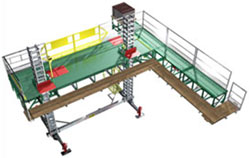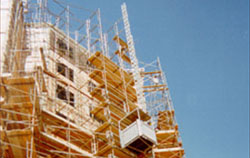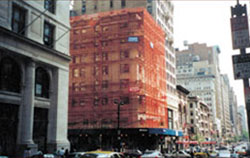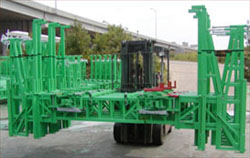March 15, 2005 7:00 AM CST

Just as women have known for years that it's the accessories that make the outfit work, mason contractors who are "in the know" are just as savvy with how to accessorize their work equipment for that perfect combination. While bangles, bracelets and diamonds are a girl's best friend, it's brackets, hoists and weather enclosures that are the jewel of the mason contractor's eye when it comes to accessorizing their scaffolding units.
"When the scaffold is at the wall, it's doing what it is supposed to do, which is making the contractors money," says Justin Breithaupt, Owner of Non-Stop Scaffolding, Inc., of Shreveport, La. "Now, there are a lot of things that contractors do with their scaffolding. They have to move it from wall to wall, job to job, and they have to use it in unusable situations, like during inclement weather. But if it's efficient in one area, but — for instance — horribly inefficient to move from wall to wall, or from job to job, then it wouldn't be doing what people bought it for. That's the reason why we have accessories."
Hydro Mobile of L'Assomption, Québec, just released its new Multi-purpose Insert at the World of Masonry show in January. While an insert may not be anything new to the masonry world, this product allows contractors to dress up their scaffold for almost any situation.
"It is important for each contractor's investment to be working for him or her as much as possible," says Chad Baumgartner, Director of Business Development for Hydro Mobile. "These accessories allow the contractor to use Hydro Mobile on every project."
In this case, the new insert has improved upon an already good idea.
"The Multi-purpose Insert is a section of bridging that can be used as a cantilever, an insert or an extension in many different directions," says Baumgartner. "It has the ability to be used one in front of another, thus replacing the Forward Extension we have offered in the past that was limited to one application only. This section adds to the flexibility of the equipment to meet all of your building configurations."
From straight lines to curvaceous corners, Non-Stop Scaffolding's inside and outside corner brackets are a great accessory, this time to accentuate the twists and turns of any building.
"These brackets snap on without tools and make our elevating scaffolding go in place for inside and outside corners faster than conventional frames can," says Breithaupt. "So for cut-up walls, sawtooth walls, the tops of inside and outside corners, ours goes in place safer and faster than frames."

To accent your scaffolding, there are also hoists, platforms and staircases to keep things moving in the right direction.
"The most popular Beta Max hoist systems used by mason contractors are our lighter, scaffold-mounted Portable Hoist Systems," says Tami Hamilton, Vice President, Marketing for Beta Max Hoists of Melbourne, Fla. "For the smaller contractor, the addition of the Scorpio Plus Hoist with the Vertical Post Mount option allows up to 400 lbs. of material to be safely brought up onto the scaffold.
"The larger contractor may opt for the Gemini Plus Hoist with the Scaff-Trac Mount or the Leo Hoist with the I-Beam Mount for lifting up to 1,200 lbs. onto the scaffold. When projects require larger loads, the rack and pinion material hoists offer large payload areas and increased capacities."
Hamilton says there are a number of great things that hoists can add to a masonry job site. They can increase safety by reducing the chances of a worker becoming injured. Productivity can increase because the hoist will keep working strong all day long, while a laborer moving materials will start to fatigue. The tendency of overloading a scaffold with materials at the beginning of the day can be exchanged with a smaller, constant delivery of materials throughout the work day. And while many mason contractors may have a telehandler or forklift on site, a hoist is able to reach higher areas that these machines can't even touch — plus, transportation is a little easier for a hoist over one of these heavy lifters.
"In all cases, the contractor removes the burden of heavy material lifting from the laborer to the equipment and realizes increased productivity and reduced labor costs, such as wages and insurance, immediately," states Hamilton.
A similar provider, Champion Elevators of Houston, Texas, manufactures material hoists that can lift 650 to 4,400 lbs., transport platforms capable of 1,100 to 3,300 lbs., and large construction elevators.
"I've been involved in some buildings that were only three stories high that needed this equipment simply because they didn't have room for a forklift to provide materials — there was no access space," says Eric Schmidt, Regional Manager for Champion Elevators. "So where that space is limited, you can slip a small unit into an area to feed a scaffold or mast climbing platform."
Schmidt feels that hoists and platforms are often overlooked by mason contractors as good alternatives for moving materials. On many projects, the contractor may be able to reduce crew size by one or two people simply by changing the means of vertical lifting.
"I think there are a lot of mason contractors who are not aware of the variety of sizes, shapes and types when it comes to this equipment," he says. "In many cases, they move a lot of material in far less efficient ways simply because they don't know what's out there."
"There are three main advantages with our aluminum staircase," says Joe Riccio, Sales for Vanguard. "You're going to cut down on the amount of time it takes to install it. Also, because they're lighter, there's going to be less fatigue, and it's going to be safer to install."
Finally, there's a certain amount of increased safety having your crew walk up a staircase.
"As opposed to climbing on the frame itself or a ladder attached to the outside of a frame, this product is a lot safer because you have inside and outside guardrails or handrails, so you're going to have a safe access," Riccio states.

When there's a nip in the air, the accessories may just need to cover up rather than accentuate what's there. Although contractors are investing time and money to set up weather enclosures, they may gain back days, weeks, maybe even months of working time during inclement weather.
Strong Man Building Products Corporation of Fairfield, N.J., is an importer and national distributor of poly tarps for weather enclosure and vertical and horizontal debris netting. For years, construction business owners have called on them for their expertise in industrial fabric to help solve their scaffolding problems.
"Our tarps enclose the scaffolds and allow contractors to heat that area, and the tarps make it where the heat does not escape during the inclement weather," says Jay Kinder, President of Strong Man. "So the heat does not go out into the atmosphere, and the men can continue to work in the winter."
Non-Stop Scaffolding says it is the only manufacturer to offer two different types of weather enclosure for mason contractors to choose from: one that rides up the scaffold, enclosing only the working area and the wall below; and the other that encloses the entire tower from the ground all the way to the top of the wall.
"The second option is for people who have used conventional frames in the same way and liked that method — their men are used to that form of enclosure," says Breithaupt. "Our weather enclosure is made of the same round tubes as conventional frames, bent along the top for a nice snag-free design, with reinforced polyethylene and wind clips.
"They are designed to be very easy to use and install, most of them with no tools at all."
Hydro Mobile believes versatility is a key ingredient with its accessories. Its weather protection system can be utilized for weather protection to keep the workers comfortable. The weather protection will completely cover the "upper section," or the working area, as well as the area eight feet below the masons' feet, protecting the green brick work from freezing before it is cured.
Serving a dual purpose, the same "Quick Install" weather enclosure frame can also double as a monorail system for transporting and setting large stone, panels or caps. Incorporating the monorail system into the weather protection is just another example of maximizing your investment.

And no outfit is complete until you have the perfect pair of shoes, or in this case, the perfect way to move your scaffolding from place to place. Non-Stop Scaffolding also makes a forklift bar and rack brackets, so moving your scaffolding from one place to another is a smooth transition.
"All of the other manufacturers, up until now, made a forklift bar that grabs hold of the vertical part of the tower," Breithaupt says. "That is a good way to grab a tower, but it's a horrible way to turn loose of a tower."
Instead, Non-Stop created a forklift bar that has a plunger on either side that goes into the rung hole openings of the tower. This allows workers to pick up the scaffolding with less risk of damaging the uprights, to be better able to place it in a level position, and less likely to get into a bind with the lifting device when setting it down. Rounding out these abilities, the forklift bar can also swivel 80 degrees in either direction, so laborers don't have to drive up perpendicular to the wall to set your towers down.
"That makes moving the scaffold from wall to wall a very simple procedure, rather than an ordeal like it's been in the past with other systems," he says.
Another ordeal can be packing up your scaffolding towers at the end of a project.
"Many contractors will take an eight-foot-wide, 20-foot-long trailer and build special fixtures within this trailer to cradle the towers," says Breithaupt. "But as one customer described it to me, while it looks great when it comes out from the manufacturer, when it comes time to put the towers back in the rack for the next job, it's like trying to put a toy back in the box at Christmas time."
Non-Stop's rack brackets allow crews to simply and efficiently clamp together up to 10 towers in a four-foot-wide bundle for easy loading and transportation.
"Then, when you get to the next job, you pull the bundles off and set them aside, and you can go back with your trailer and move other things," he adds. "You don't have a trailer that is held captive because it has these tower racks."
In some cases of short-term use, if you own the scaffolding, it's more profitable to rent the accessories.
"Typically contractors will buy enough equipment and accessories to accommodate 80% of the type of work that they do in any given year," says Hydro Mobile's Baumgartner. "When they do get a project that requires more than they own, it is typical that they rent these items if they are only required for a short time from a local dealer."
In other cases of long-term use, it's easy for mason contractors to own the accessories, even if they are using various types of scaffold or renting the units.
"Beta Max provides mounting options that will adapt our hoists to frame scaffolding, mason's scaffolding and even special brackets for use with several of the continuous-climbing scaffolds available today," says Hamilton. "This allows the contractor to purchase a hoist system and by simply changing mounting options, use the hoist on several different work areas."
"We're open to suggestions for accessories, and we welcome building them," Breithaupt explains. "What one contractor faces now, another will inevitably face again in the future. We would rather have a solution for him all ready to go."
Accessorize Your Outfit

Image courtesy of Hydro Mobile.
"When the scaffold is at the wall, it's doing what it is supposed to do, which is making the contractors money," says Justin Breithaupt, Owner of Non-Stop Scaffolding, Inc., of Shreveport, La. "Now, there are a lot of things that contractors do with their scaffolding. They have to move it from wall to wall, job to job, and they have to use it in unusable situations, like during inclement weather. But if it's efficient in one area, but — for instance — horribly inefficient to move from wall to wall, or from job to job, then it wouldn't be doing what people bought it for. That's the reason why we have accessories."
Inserts and Brackets
First, let's slip into something a little more comfortable, like any one of the inserts, bridges or brackets that are available to extend the capabilities of your scaffolding.Hydro Mobile of L'Assomption, Québec, just released its new Multi-purpose Insert at the World of Masonry show in January. While an insert may not be anything new to the masonry world, this product allows contractors to dress up their scaffold for almost any situation.
"It is important for each contractor's investment to be working for him or her as much as possible," says Chad Baumgartner, Director of Business Development for Hydro Mobile. "These accessories allow the contractor to use Hydro Mobile on every project."
In this case, the new insert has improved upon an already good idea.
"The Multi-purpose Insert is a section of bridging that can be used as a cantilever, an insert or an extension in many different directions," says Baumgartner. "It has the ability to be used one in front of another, thus replacing the Forward Extension we have offered in the past that was limited to one application only. This section adds to the flexibility of the equipment to meet all of your building configurations."
From straight lines to curvaceous corners, Non-Stop Scaffolding's inside and outside corner brackets are a great accessory, this time to accentuate the twists and turns of any building.
"These brackets snap on without tools and make our elevating scaffolding go in place for inside and outside corners faster than conventional frames can," says Breithaupt. "So for cut-up walls, sawtooth walls, the tops of inside and outside corners, ours goes in place safer and faster than frames."
Hoists and Platforms

Image courtesy of Champion Elevators.
"The most popular Beta Max hoist systems used by mason contractors are our lighter, scaffold-mounted Portable Hoist Systems," says Tami Hamilton, Vice President, Marketing for Beta Max Hoists of Melbourne, Fla. "For the smaller contractor, the addition of the Scorpio Plus Hoist with the Vertical Post Mount option allows up to 400 lbs. of material to be safely brought up onto the scaffold.
"The larger contractor may opt for the Gemini Plus Hoist with the Scaff-Trac Mount or the Leo Hoist with the I-Beam Mount for lifting up to 1,200 lbs. onto the scaffold. When projects require larger loads, the rack and pinion material hoists offer large payload areas and increased capacities."
Hamilton says there are a number of great things that hoists can add to a masonry job site. They can increase safety by reducing the chances of a worker becoming injured. Productivity can increase because the hoist will keep working strong all day long, while a laborer moving materials will start to fatigue. The tendency of overloading a scaffold with materials at the beginning of the day can be exchanged with a smaller, constant delivery of materials throughout the work day. And while many mason contractors may have a telehandler or forklift on site, a hoist is able to reach higher areas that these machines can't even touch — plus, transportation is a little easier for a hoist over one of these heavy lifters.
"In all cases, the contractor removes the burden of heavy material lifting from the laborer to the equipment and realizes increased productivity and reduced labor costs, such as wages and insurance, immediately," states Hamilton.
A similar provider, Champion Elevators of Houston, Texas, manufactures material hoists that can lift 650 to 4,400 lbs., transport platforms capable of 1,100 to 3,300 lbs., and large construction elevators.
"I've been involved in some buildings that were only three stories high that needed this equipment simply because they didn't have room for a forklift to provide materials — there was no access space," says Eric Schmidt, Regional Manager for Champion Elevators. "So where that space is limited, you can slip a small unit into an area to feed a scaffold or mast climbing platform."
Schmidt feels that hoists and platforms are often overlooked by mason contractors as good alternatives for moving materials. On many projects, the contractor may be able to reduce crew size by one or two people simply by changing the means of vertical lifting.
"I think there are a lot of mason contractors who are not aware of the variety of sizes, shapes and types when it comes to this equipment," he says. "In many cases, they move a lot of material in far less efficient ways simply because they don't know what's out there."
Staircases
If you're looking for something a little less sophisticated, maybe the new aluminum staircase by Vanguard of New Ipswich, N.H., is more your style. The aluminum design is about half the weight of its conventional frame counterparts, while the construction allows one laborer to install in "just a matter of seconds.""There are three main advantages with our aluminum staircase," says Joe Riccio, Sales for Vanguard. "You're going to cut down on the amount of time it takes to install it. Also, because they're lighter, there's going to be less fatigue, and it's going to be safer to install."
Finally, there's a certain amount of increased safety having your crew walk up a staircase.
"As opposed to climbing on the frame itself or a ladder attached to the outside of a frame, this product is a lot safer because you have inside and outside guardrails or handrails, so you're going to have a safe access," Riccio states.
Weather Enclosures

Image courtesy of Strong Man Building Products Corporation.
Strong Man Building Products Corporation of Fairfield, N.J., is an importer and national distributor of poly tarps for weather enclosure and vertical and horizontal debris netting. For years, construction business owners have called on them for their expertise in industrial fabric to help solve their scaffolding problems.
"Our tarps enclose the scaffolds and allow contractors to heat that area, and the tarps make it where the heat does not escape during the inclement weather," says Jay Kinder, President of Strong Man. "So the heat does not go out into the atmosphere, and the men can continue to work in the winter."
Non-Stop Scaffolding says it is the only manufacturer to offer two different types of weather enclosure for mason contractors to choose from: one that rides up the scaffold, enclosing only the working area and the wall below; and the other that encloses the entire tower from the ground all the way to the top of the wall.
"The second option is for people who have used conventional frames in the same way and liked that method — their men are used to that form of enclosure," says Breithaupt. "Our weather enclosure is made of the same round tubes as conventional frames, bent along the top for a nice snag-free design, with reinforced polyethylene and wind clips.
"They are designed to be very easy to use and install, most of them with no tools at all."
Hydro Mobile believes versatility is a key ingredient with its accessories. Its weather protection system can be utilized for weather protection to keep the workers comfortable. The weather protection will completely cover the "upper section," or the working area, as well as the area eight feet below the masons' feet, protecting the green brick work from freezing before it is cured.
Serving a dual purpose, the same "Quick Install" weather enclosure frame can also double as a monorail system for transporting and setting large stone, panels or caps. Incorporating the monorail system into the weather protection is just another example of maximizing your investment.
The 'Movers and Shakers'

Image courtesy of Non-Stop Scaffolding.
"All of the other manufacturers, up until now, made a forklift bar that grabs hold of the vertical part of the tower," Breithaupt says. "That is a good way to grab a tower, but it's a horrible way to turn loose of a tower."
Instead, Non-Stop created a forklift bar that has a plunger on either side that goes into the rung hole openings of the tower. This allows workers to pick up the scaffolding with less risk of damaging the uprights, to be better able to place it in a level position, and less likely to get into a bind with the lifting device when setting it down. Rounding out these abilities, the forklift bar can also swivel 80 degrees in either direction, so laborers don't have to drive up perpendicular to the wall to set your towers down.
"That makes moving the scaffold from wall to wall a very simple procedure, rather than an ordeal like it's been in the past with other systems," he says.
Another ordeal can be packing up your scaffolding towers at the end of a project.
"Many contractors will take an eight-foot-wide, 20-foot-long trailer and build special fixtures within this trailer to cradle the towers," says Breithaupt. "But as one customer described it to me, while it looks great when it comes out from the manufacturer, when it comes time to put the towers back in the rack for the next job, it's like trying to put a toy back in the box at Christmas time."
Non-Stop's rack brackets allow crews to simply and efficiently clamp together up to 10 towers in a four-foot-wide bundle for easy loading and transportation.
"Then, when you get to the next job, you pull the bundles off and set them aside, and you can go back with your trailer and move other things," he adds. "You don't have a trailer that is held captive because it has these tower racks."
Buy or Rent?
While trendsetters in the fashion world typically have to purchase their baubles, mason contractors have the choice of purchasing or renting the accessories of their desires.In some cases of short-term use, if you own the scaffolding, it's more profitable to rent the accessories.
"Typically contractors will buy enough equipment and accessories to accommodate 80% of the type of work that they do in any given year," says Hydro Mobile's Baumgartner. "When they do get a project that requires more than they own, it is typical that they rent these items if they are only required for a short time from a local dealer."
In other cases of long-term use, it's easy for mason contractors to own the accessories, even if they are using various types of scaffold or renting the units.
"Beta Max provides mounting options that will adapt our hoists to frame scaffolding, mason's scaffolding and even special brackets for use with several of the continuous-climbing scaffolds available today," says Hamilton. "This allows the contractor to purchase a hoist system and by simply changing mounting options, use the hoist on several different work areas."
Conclusion
It is mason contractors who are driving the innovation of these accessories. All of the manufacturers we spoke with say that they're eager to continue providing solutions for the industry and to help make mason contractors more profitable and their work more efficient."We're open to suggestions for accessories, and we welcome building them," Breithaupt explains. "What one contractor faces now, another will inevitably face again in the future. We would rather have a solution for him all ready to go."
About the Author
Jennie Farnsworth is an Atlanta-based freelance writer and editor. She is a former editor of Masonry magazine.


















